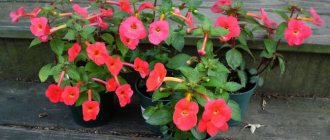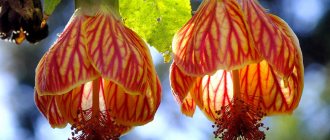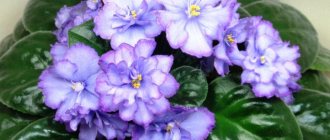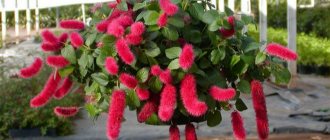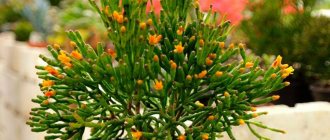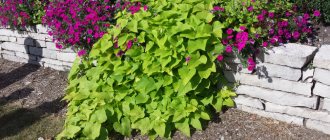Pandanus is a false palm from the Pandanaceae family.
The exotic screw palm is native to the tropics of the eastern hemisphere. Pandanus can be found in Vietnam, Madagascar and Java, Australia, the Marshall Islands, Thailand and the Philippines. It grows on sea coasts, river banks, and tropical rainforests.
Most often, pandanuses grow in coastal areas
In the natural environment, there are specimens whose sizes vary from small shrubs less than 1 m high to trees 20 m high. The trunk is thick, highly branched. Depending on the species, it may be smooth or warty. Aerial or stilted roots form a pyramid, holding the trunk and a massive crown of leaves and fruits. The upper part of the plant has one or more crowns of ribbon-like leaves, which may be spiny. The length of the leaf plates (depending on the type) ranges from 30 cm to 2 m, and the width varies from 1.5 cm to 10 cm.
In Southeast Asian countries such as Thailand and the Philippines, local people use the leaves of the plant for cooking. They have a pleasant herbal aroma and are used to wrap rice, meat or fish during cooking. Baskets are woven from pandanus leaves and filled into mattresses, and rafts are made from trunks.
The plant is dioecious. The male tree's flowers are long and fragrant, while the female pandanus bears round flowers that are also surrounded by bracts. The fruits are drupes that merge into one spherical fruit with a diameter of 10–20 cm, which looks like a pineapple. The color changes from green to bright orange or red as it ripens. The fruits can remain on the tree for more than 12 months.
Externally, the pandanus fruit resembles a pineapple
Pandanus Veitch, Sandera and other species
Of the 600 plant species found naturally, only a few are suitable for growing as potted plants.
- Veitch's pandanus (P. veitchii). A spiral palm with a shortened trunk and stilted roots that serve as supports. The leaf blades are twisted in a spiral along the shoot. The width of the leathery leaves, painted in a bright green shade, is 5–7 cm, and the length is 60–90 cm. Veitch's pandanus grows up to 1.5 m in height. The variegated form of this species is very impressive.
- Pandanus useful (P. utilis). A fairly large indoor plant that grows up to 2–3 m. Bright green leaves, covered at the edges with thorns, colored in a reddish tint, are arranged in a spiral. The leaf blades grow up to 1.5 m in length.
- Pandanus Sandera (P. sanderi). The leaf blades reach 80 cm in length and 5 cm in width, they are dark green with thin yellowish stripes and small spines along the edges.
- Pandanus Baptista. The plant is powerful, reaching a height of 2 m. Narrow and leathery leaves are decorated with yellow stripes. The edges of the leaf plates are smooth, without thorns.
- Roofing pandanus. This type of screw palm grows up to 1.5 m in height. Stilted (aerial) roots extend from a shortened trunk. The narrow leaves have serrated edges. The leaf blades are large, they grow up to 90 cm in length and up to 8 cm in width. The leathery leaves are colored green. The species got its name due to the fact that local residents use dense leaf plates as material for roofs of houses. They are also used to make ropes, baskets, hats and other household items.
Types in the photo
Pandanus Veitch is the most common species in indoor floriculture.
A distinctive feature of pandanus useful is the reddish thorns along the edges of the leaves.
The leaves of Pandanus Sander are decorated with thin yellowish stripes.
Pandanus Baptista - a spectacular plant with leaves decorated with yellow stripes
Pandanus roofing leaves are very durable, which is why they are used as a material for roofs.
Screw palm in nature - video
Reproduction
Pandanus reproduces in several ways depending on the species:
- cuttings;
- seeds;
- division.
Some varieties do not produce shoots, for example, Pandanus useful. Cuttings are cut from side shoots , only if they have aerial roots, choosing the largest ones (up to 20 cm), planted in a sand-peat mixture, and covered with glass.
The cut wounds are sprinkled with charcoal and dried. They are kept in a greenhouse for 2 months, regularly ventilated and watered, then planted. Rooting usually occurs quickly and without problems.
Seeds are sown immediately after collection in a substrate of sand and leaf soil, covered with glass, periodically sprayed and ventilated. After 5-6 weeks, when the young seedlings have 2-3 true leaves, they are planted in a separate bowl.
Numerous “babies” that have developed on an adult pandanus and have roots less than 15 cm are separated and planted in pots. Drainage is placed at the bottom of the container, then a layer of turf soil and sand.
The rosette is deepened into the soil mixture by 2 cm , covered with moss and covered with a cap. After rooting, they are planted in separate pots.
Living conditions depending on the season
| Season | Humidity | Content temperature | Lighting |
| Spring-summer | Pandanus tolerates dry indoor air well, but it is impossible to constantly keep the plant at low humidity; the flower may die. The optimal level should be 60%. This can be achieved by periodically spraying the leaves. | + 20–22 оС | The screw palm requires bright but diffused light. To avoid burns, the pandanus should be placed near the eastern or south-eastern window, curtained with tulle. Some species (with green leaf color) are shade-tolerant. A pot with green-leaved pandanus can also be placed in the back of the room. |
| Autumn-winter | With the onset of the heating season, the plant should be placed away from the radiators and the pot should be placed on a tray with wet expanded clay or pebbles. This technique will help maintain the required level of humidity. | + 18–20 oC. Can withstand short-term temperature drops of up to 12 degrees. | In winter, it is best to place the flower near a window facing South. If the plant is large and it is problematic to place it on the windowsill, then you should provide the pandanus with additional lighting using a phytolamp installed at a distance of 30–40 cm from the crown of the flower. |
Botanical description
Pandanuses are tree-like evergreens, sometimes shrubs, reaching a height of 10-15 and sometimes 25 m in natural conditions. Externally, these plants look like vines or palm trees. Pandanus often form aerial roots, which eventually grow into the soil. With age, the lower part of the trunk of pandanus dies, and the plant is kept in an upright position precisely due to the aerial roots that have grown into the soil and become lignified, which are called stilts.
The leaves of pandanus are linear, xiphoid, slightly grooved, sharply serrated at the edges, up to 4 m long and up to 15 cm wide. They are located on the trunk in two spiral rows, which is why pandanus is called a screw tree or a screw palm. With age, the lower leaves fall off and scars remain in their place. The flowers of the plant are small, yellow, unisexual, without a perianth, collected in panicles or on cobs; however, pandanuses bloom infrequently in cultivation.
The screw palm is an unpretentious plant for spacious halls and winter gardens, which easily tolerates a lack of light and moisture, grows quickly, but requires a lot of space, so only young pandanuses can be kept in an apartment.
- Fatsia
The nuances of caring for pandanus
The plant is quite unpretentious, but in order to achieve rapid growth and a spectacular appearance, it is necessary to take into account several features.
Watering
The screw palm is quite moisture-loving, so the substrate in the pot should not be allowed to dry out completely. On warm days in spring and summer, I provide the pandanus with abundant watering, and in autumn and winter I reduce the amount of moisture by half. I make sure that the moisture does not stagnate in the pot; I drain excess water from the pan an hour after moistening.
Aerial roots also need moisture. To do this, they are covered with damp (but not wet) sphagnum moss.
Cold water should not be used to water the screw palm; it is best if it is at room temperature. It is not recommended to spray pandanus, as water that gets into the middle of the rosette can cause rot. But the air around the plant needs to be sprayed, especially on hot days, since the screw palm, like any other inhabitant of the tropics, needs high humidity.
Dust often accumulates on large leaves. They are wiped with a damp sponge from the base towards the tips. It is not recommended to give pandanus a shower, since, as already mentioned, water that gets into the base of the leaves can cause the plant to rot.
Top dressing
The beautiful pandanus requires large amounts of mineral and organic nutrients. In the spring and summer, it is fed twice a month with liquid complex fertilizers, which contain both mineral components and organic biostimulants. Root feeding with Ideal and Bona Forte gives good results. Half a cap of the product is diluted in 1.5 liters of settled water. The pandanus is watered with this nutrient liquid, and the procedure is carried out an hour after watering with ordinary water.
A special concentrated fertilizer for ficus and palm trees is perfect for feeding pandanus.
Rest period
Pandanus does not have a clearly defined dormant period; it continues to grow even in winter. But during periods of short daylight hours, the plant should be illuminated with a fluorescent lamp. Pandanus does not tolerate coolness well, so it is best to maintain a temperature of around +20 °C.
Planting and transplanting
For normal development, a young pandanus needs an annual change of pot for 5 years. Moreover, the new pot should not be large in size; it is permissible to exceed the previous one by only 2 or 3 cm. The bottom should have holes to remove excess moisture. Young specimens can be planted in plastic containers. For large plants you need to choose a stable pot. When purchasing a pot, do not forget to buy medium-sized drainage. For large containers it is better to use a large fraction.
Adult pandanuses are replanted no more than once every 3 years. The new container should be approximately 1/3 higher than the previous one. The width of the pot is standard. The apparent power of aerial roots is actually very deceptive. They are very fragile, so replanting is done exclusively by transferring the plant from one container to another. Removing such roots is strictly prohibited. To prevent them from drying out, you can use wet moss wraps.
The aerial roots of pandanus are very fragile, so you need to be extremely careful when replanting.
Potted plants are not replanted at all. For them, it will be enough to replace the top layer of soil in the tub with a more nutritious one. This is done once a year or 2 times. When the pandanus is prepared for transplanting into a tub, not 1, but 3 parts of turf soil are added to the prepared earthen substrate so that the plant has enough nutrients for a long time.
To curb the growth of pandanus, replanting is carried out less frequently, only replacing the top layer of soil, just like in tub specimens.
The soil for pandanus needs to be nutritious and loose, but containing a small amount of clay. You can use commercial palm substrate. Those who like to make soil mixtures with their own hands need to mix the following components in equal parts:
- greenhouse soil - 2 parts;
- clay soil - 1 part;
- peat - 1 part;
- coarse sand - 1 part.
Or this option - turf and leaf soil, river sand and humus. The components are taken in equal parts.
When preparing the soil, mix all ingredients well
Soil acidity also matters. A suitable pH is around 6.
Step-by-step transplant process
- Pour drainage into a new container in a layer of 1/3 of the total volume.
- Place a small portion of the substrate on top.
Place a layer of soil over the drainage
- The edges of the leaves of an adult pandanus are strewn with sharp spines. Therefore, when starting work, first put on gloves. Then carefully collect the leaves of the plant into a bunch and tie with a ribbon. Otherwise, scratches cannot be avoided.
- With the pot on its side and carefully using a flat spatula, remove the plant. There is no need to clear the soil from its roots.
- Place the pandanus in the center of the new pot. Holding the plant, add the rest of the soil to the sides.
Holding the pandanus, add the remaining soil mixture
- To compact the soil and fill the space between the roots, water the plant. Wait for excess water to collect in the pan and drain.
- The planting level of the pandanus should remain the same, and the aerial roots should remain above the soil surface.
Pandanus purchased in a store cannot be replanted immediately. The plant must be given time to adapt - about 10 days.
Does pandanus need support?
In general, pandanus does not need support. But there are situations when the flower begins to grow one-sidedly. This happens with overgrown and not transplanted plants in time, moreover, located in a room with dry air. Under such conditions, aerial roots stop growing and cannot further support the flower. If you can’t replant, then place a support next to the pandanus - a strong bamboo stick will do.
There are situations in which a pandanus cannot survive without support.
Possible problems during cultivation - table
| Problem | Cause | Elimination methods |
| The appearance of a brown tint on the tips of leaves |
|
|
| Yellowing of leaves |
|
|
| Loss of color intensity |
|
|
| Drying leaves | Burn from direct rays of the sun. | It is better to move the palm tree to a semi-shaded place. |
Signs
Is it possible to keep pandanus at home?
Despite the well-deserved popularity of pandanus, sometimes readers of our site ask whether it is possible to keep it in an apartment. Rumor has it that it absorbs positive emotions and transforms them into aggressive energy, which negatively affects unbalanced people, making them angry and overactive. What's the answer here? If you are impressionable and have a hard time withstanding troubles, you may experience discomfort near the pandanus. In this case, it is better for you not to keep the plant either at home or at work. And for people with a strong nervous system, novice gardeners and those who often go on business trips, pandanus is an ideal plant: it is beautiful, unpretentious, does not require frequent watering and grows quickly.
Pests
Pests can cause great damage to the screw palm. They lead to withering of the flower and deformation of the leaf plates.
| Pests | Symptoms | Reasons for appearance | Ways to get rid of pests |
| Shields |
| dry air |
|
| Spider mites |
| increased air humidity |
|
| Mealybugs |
| dry air | Soak a cotton swab in water, lather it, and remove pests and their secretions from all parts of the pandanus. |
Pests threatening pandanus - photo gallery
The presence of cobwebs on the reverse side of the leaf blades is the main sign of spider mite damage.
The characteristic white discharge on the leaves and trunk is the result of mealybug activity.
Pests hide under round brown shields
Benefits or harms of pandanus
Palma domestica - an exotic indoor flower
While it is almost impossible to see exotic flowers blooming at home, in nature the plant blooms very beautifully. During this period, the tree is decorated with spikelets of numerous small inflorescences. The flowers do not have perianths, but have covering leaves.
The plant is unisexual. Therefore, male flowers appear on one bush. They resemble elongated spikelets. On the female, the inflorescences are shaped like corn cobs. The flowering of exotic flowers is accompanied by a subtle, pleasant fruity aroma.
The fruit resembles a pineapple. As it grows, it becomes clear that the fruit has its own characteristics and only vaguely resembles a pineapple.
It is difficult to collect fruit from the infructescence. They can be compared to very large kernels of corn.
Residents of the Pacific Islands and Papua New Guinea cannot imagine their diet without pandanus fruits. Pandan fruit provides people with vitamins, gives them a boost of energy and satiation. Fruits are boiled, cooked over a fire or eaten fresh. It is noteworthy that not only the fruits of the plant are edible, but also the lower parts of the foliage and inflorescences.
Pandan fruit
Some tourists believe that pandan is poisonous. This is wrong. The fruit is edible and not capable of causing harm. On the contrary, pandan is healthy.
For example:
- Seed oil tones the body and benefits the nervous system.
- The oil is used to relieve migraines and headaches.
- The leaves are suitable for healing wounds, abscesses, and skin diseases.
- The pulp from the leaves helps in the treatment of infectious diseases such as leprosy (leprosy), etc.
Beneficial properties of pandan and use in folk medicine
Pandanus fruit is a source of phosphorus, iron, calcium, ascorbic acid, vitamins A, B and D, fiber, thiamine, so the fruit is widely used in folk medicine. Pandan has the following properties:
- Boosts immunity and helps fight infections;
- speeds up metabolism;
- strengthens blood vessels and reduces swelling;
- improves lung performance;
- helps cope with insomnia and stress;
- relieves joint pain due to arthritis.
Pandan seed oil has a tonic effect, and tea from the flowers is used as a sedative. A decoction of the dried roots of this tree is used as an antipyretic or diuretic. In addition, dried pandanus leaf extract is used to relieve toothache, and some even simply chew the leaves for fresh breath.
A paste of pandan leaves and warm water has an antifungal effect. This hair mask prevents dandruff. The leaves also have regenerating properties and renew the skin, so they are often taken in baths.
INTERESTING FACT . Fresh pandan fruit cannot be bought in Russia, as it cannot withstand long-term transportation. But dried pandan leaves are widely sold. The average price is 500–600 rubles per 100 g. Dried tree flowers and fruit seeds are also sometimes sold.
Uses of pandan leaves in folk medicine
Contraindications for use
Since the beneficial properties of pandan have not been confirmed in traditional medicine, the fruits and leaves of the tree should be consumed in doses. Eating the fruit in large quantities can lead to weight gain (due to the increased sugar content), and in people with individual intolerance, pandan can cause an allergic reaction (itching, redness of the skin, nausea).
Pandan is contraindicated in pregnant and breastfeeding women, and it is also best to avoid consuming pandan leaves (and their infusions) for people who have kidney disease.
Diseases
If water stagnates in a pot, the plant may suffer from root rot. This fungal disease can be prevented by maintaining proper watering patterns.
But if the disease has already affected the plant, you need to replant it in new soil, after cutting off all the rotten parts.
Pandanus usually does not suffer from pests of indoor and garden plants . But if the palm tree was kept in the open air, a scale insect may settle on it.
You can get rid of this insect by manually collecting adult individuals.
But due to the large size of the palm tree, this is difficult to do; it is easier to use insecticidal preparations that will completely destroy the pest.
If the leaves turn yellow
Pandanus diseases are rarely associated with pests; most often the cause lies in violation of maintenance rules. So why do palm leaves turn yellow? Such indoor plants need good lighting. If the color of the leaves has changed, then you should immediately think about the lack of sunlight. Move the pot closer to the window or turn on the lamps.
An important nuance is that on one side they turn yellow or spread evenly across the crown. If the color disappears locally, most likely the plant needs to be turned “gray” towards the sun.
Aerial roots become a serious difficulty. They definitely appear on every pandanus. Taking into account the fact that there is no proper protection and humidity from the ground, they must be monitored separately. It is best to cover them with moss and keep them moist at all times.
Peculiarities
This plant is very unpretentious, but in a draft its growth slows down and the leaves begin to dry out.
Prolonged exposure to a draft can be detrimental to pandanus, so the pot with the plant should be placed away from opening windows.
Pandanus is a large and heavy plant that can become unstable in uneven light conditions. It is advisable to rotate it so that it has a straight trunk and does not lean to one side.
Watering
Pandanus is quite drought-resistant and can go without watering for a long time. But this does not mean that it needs to be watered rarely.
In the summer heat, the palm tree is watered generously every 2-3 days , as the soil in the pot dries out on top.
It is necessary to ensure that water does not stagnate in the soil.
The plant should not be watered with cold water. The water temperature for irrigation should be about 30ºС. It is also advisable to leave the water for 2-3 days.
In winter, when pandanus is kept at low temperatures, watering is significantly reduced . Water the palm tree once every 2-3 weeks to prevent the development of fungal diseases caused by waterlogging.

